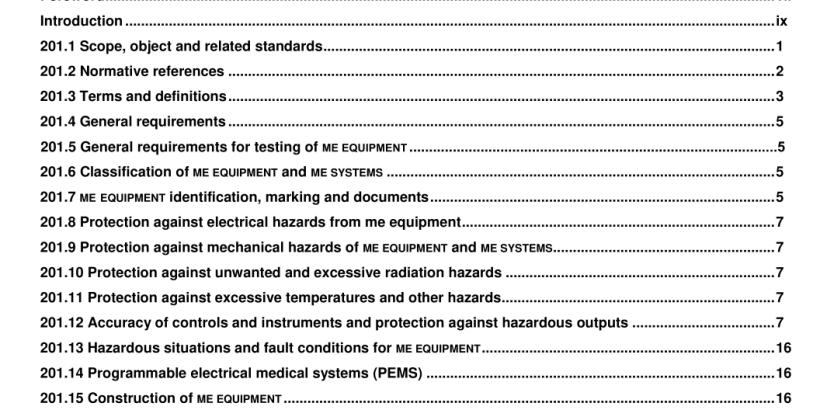ANSI AAMI IEC 80601-2-58-2014 pdf download
ANSI AAMI IEC 80601-2-58-2014 pdf download.Medical electrical equipment
In the IEC 60601 series, particular standards may modify, replace or delete requirements contained in the general standard and collateral standards as appropriate for the particular ME EQUIPMENT under consideration, and may add other BASIC SAFETY and ESSENTIAL PERFORMANCE requirements. A requirement of a particular standard takes priority over the general standard. For brevity, IEC 60601 -1 is referred to in this particular standard as the “general standard”. Collateral standards are referred to by their document number. The numbering of clauses and subclauses of this particular standard corresponds to that of the general standard with the prefix “201 ” (e.g. 201 .1 in this standard addresses the content of Clause 1 of the general standard) or applicable collateral standard with the prefix “20x” where × is the final digit(s) of the collateral standard document number (e.g. 202.4 in this particular standard addresses the content of Clause 4 of the 60601 -1 -2 collateral standard, 203.4 in this particular standard addresses the content of Clause 4 of the 60601 -1 -3 collateral standard, etc.). The changes to the text of the general standard are specified by the use of the following words: ”Replacement” means that the clause or subclause of the general standard or applicable collateral standard is replaced completely by the text of this particular standard. “Addition” means that the text of this particular standard is additional to the requirements of the general standard or applicable collateral standard. “Amendment” means that the clause or subclause of the general standard or applicable collateral standard is amended as indicated by the text of this particular standard. Subclauses, figures or tables which are additional to those of the general standard are numbered starting from 201 .1 01 . However due to the fact that definitions in the general standard are numbered 3.1 through 3.1 39, additional definitions in this standard are numbered beginning from 201 .3.201 . Additional annexes are lettered AA, BB, etc.
Subclauses, figures or tables which are additional to those of a collateral standard are numbered starting from 20x, where “x” is the number of the collateral standard, e.g. 202 for IEC 60601 -1 -2, 203 for IEC 60601 -1 -3, etc. The term “this standard” is used to make reference to the general standard, any applicable collateral standards and this particular standard taken together. Where there is no corresponding clause or subclause in this particular standard, the clause or subclause of the general standard or applicable collateral standard, although possibly not relevant, applies without modification; where it is intended that any part of the general standard or applicable collateral standard, although possibly relevant, is not to be applied, a statement to that effect is given in this particular standard.
The instructions for use shall additionally include the following warning and safety notices:
a) a warning to use only recommended TUBING SET (s);
b) if an electrically adjustable ophthalmic IRRIGATION solution support pole is used, a warning not to modify pole height or manually force the pole height because this could cause incorrect indication of bottle height and PATIENT injury;
c) a warning never to intentionally modify HANDPIECES or TIPS (e.g. do not bend, cut, or engrave them) as they could break or malfunction;
d) a warning to the OPERATOR not to touch an activated ultrasonic HANDPIECE TIP , as injuries could occur;
e) if applicable, warnings related to lamp replacement (e.g. RISK of injury, ratings of lamp, damage to lamp, damage to machine, etc.);
f) if applicable, a warning to the OPERATOR that care should be taken to avoid concentrating the output of an illumination module on a small area of the retina for unnecessarily prolonged periods of time due to the potential for PHOTORETINITIS and serious permanent PATIENT injury;
g) if applicable, a warning to the OPERATOR that inadvertent activation of functions that are intended for PRIMING or tuning HANDPIECES while the HANDPIECE is in the eye can create a HAZARDOUS SITUATION that could result in PATIENT injury;
